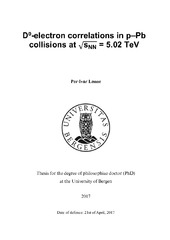| dc.description.abstract | In collisions of lead nuclei at the Large Hadron Collider (LHC) at CERN, a state of matter called Quark-Gluon Plasma (QGP) is formed, where quarks and gluons are no longer confined into hadrons. Heavy-flavour quarks, i.e., charm and beauty, are effective probes for studying the QGP, as their relatively large mass limits their production predominantly, if not exclusively, to hard scattering processes in the very first moments of the collisions, before the QGP formation. As the quarks propagate through the hot and dense medium created in the Pb–Pb collisions they interact with the medium and lose energy via elastic collisions and gluon radiation. The study of the modification of angular correlations between D mesons and electrons from heavyflavour hadron decays in Pb–Pb collisions with respect to pp and p–Pb collisions can provide relevant information on the energy-loss mechanism. This applies in particular to the dependence of the correlation on the path length traversed by the charm quark in the medium, and to possible medium modifications of charm-quark fragmentation and hadronisation. In pp collisions, these measurements can be sensitive to the different production processes of heavy-flavour quarks, e.g., pair production vs. gluon splitting, and measurements in p–Pb collisions yields information on Cold Nuclear Matter (CNM) effects related to the structure of the initial state of the particle collisions, e.g., the additional effects caused by introducing a lead nucleus in p–Pb collisions compared to pp collisions. In this thesis, the measurement of azimuthal correlations of D mesons and electrons from heavy-flavour hadron decays in p–Pb collisions at p sNN = 5:02 TeV will be presented, in the D0 → K-π+ decay channel. The analysed data originate from collisions of protons with lead ions, facilitated by the LHC at CERN in the beginning of 2013, recorded by the ALICE experiment, a dedicated heavy-ion detector focusing on studies of the QGP. A compatibility within the statistical uncertainties was found while comparing correlation distributions in the pp and p–Pb collision systems, though indications of a discrepancy in the shape of the away side peak between the two cases was observed, where the peak in p–Pb appears less pronounced. The statistical challenges of the limited data sample available in the p–Pb collisions result in large statistical uncertainties and fluctuations in the correlation distributions. A detailed study of the heavy-flavour electron (HFE) sample was performed in order to optimize the selection efficiency and HFE purity, leading to excellent utilization of the available data. The presented results provide an important step on the path to studies of D0-e correlations in Pb–Pb collisions, and displays great potential to further the understanding of the interactions of heavy quarks traversing the hot and dense medium created in ultra-relativistic heavy ion collisions. As a concluding remark, the performance expected after the upgrade of the ALICE detector during the long shutdown in 2018 will be shown. | en_US |
